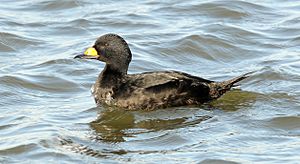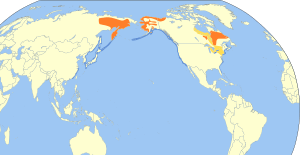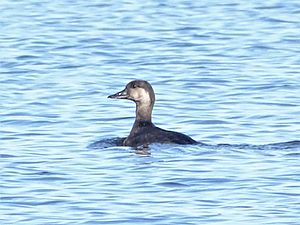Black scoter facts for kids
Quick facts for kids Black scoter |
|
|---|---|
 |
|
| Adult male | |
| Conservation status | |
| Scientific classification | |
| Genus: |
Melanitta
|
| Species: |
americana
|
 |
|
| Synonyms | |
|
Melanitta nigra americana |
|
The black scoter (Melanitta americana), also called the American scoter, is a large sea duck. These ducks are about 43 to 49 centimeters (17 to 19 inches) long. Their scientific name, Melanitta americana, comes from Greek and Latin words. Melas means "black" in Ancient Greek, and netta means "duck." The word "americana" means "American" in Latin.
Sometimes, the black scoter is considered very similar to the common scoter. In parts of Canada, people call it macreuse noire, which also means "black scoter." The IUCN (International Union for Conservation of Nature) lists this species as "Near Threatened." This means it could become endangered in the future if we don't protect it.
Contents
What Does the Black Scoter Look Like?
The black scoter is a big sea duck with a strong body and a large bill.
Male and Female Black Scoters
The adult male black scoter is completely black. It has a very round, yellow bill. The adult female is brown with lighter-colored cheeks. She looks a lot like a female common scoter.
Female black scoters usually weigh about 980 grams (2.2 pounds) and are about 45 centimeters (18 inches) long. Male black scoters are a bit bigger. They weigh around 1100 grams (2.4 pounds) and are about 49 centimeters (19 inches) long.
You can tell black scoters apart from most other scoters. Male black scoters do not have any white feathers. Female black scoters have more pale areas on their faces than other scoter females.
How Black Scoters Communicate
Black scoters and common scoters make different sounds. This helps scientists tell them apart just by listening to their calls.
Where Do Black Scoters Live?
Black scoters live in the northern parts of the world.
Breeding and Wintering Areas
They breed in the far north of North America. This includes places like Labrador and Newfoundland in Canada. They also breed near Hudson Bay. You can also find them on the Siberian side of the Bering Strait in Asia.
When winter comes, black scoters fly south to warmer places. They spend the winter along the coasts of the northern United States and Canada. On the Pacific Ocean coast, they fly as far south as the San Francisco Bay area. On the Atlantic Ocean and Gulf of Mexico coasts, they also spend their winters. In Asia, they fly as far south as China.
Some black scoters might stay on the Great Lakes during winter. It is very rare to see this bird in western Europe. It's hard to identify females that are out of their usual range.
Black Scoter Behavior and Diet
Black scoters are interesting birds that find their food in the water.
What Black Scoters Eat
When they are migrating or spending winter on the coast, they dive underwater. They look for crabs and molluscs (like clams or snails). When they are nesting near freshwater, they eat different things. They feed on insects and their young, especially caddisflies. They also eat fish eggs and sometimes plants like duckweed.
Social Life of Black Scoters
In winter, black scoters gather in large groups on the coast. These groups are very close together. The birds often take off into the air all at once. During the breeding season, they are not as social. It seems they prefer calm bays and waters with different depths when they are near the coast.
Nesting and Raising Young
Black scoters build their nests later in the year than most other ducks in North America. Pairs of ducks form in late winter or spring. They build their nests on the ground, usually close to the sea, lakes, or rivers. They might build them in woodlands or tundra areas.
A female black scoter usually lays 5 to 7 eggs. Each egg weighs about 60 to 74 grams (2.1 to 2.6 ounces). This is about 8% of the female's body weight! The eggs hatch after about 27 to 31 days. The female stays with her young for about three weeks. After that, the young ducks, who still cannot fly, must find food for themselves.
When a male black scoter stretches his wings, he makes a special head movement. He moves his head downwards in a unique way.
See also
 In Spanish: Negrón americano para niños
In Spanish: Negrón americano para niños



